BUSN20017: Intercultural Communication Report for Backpack Bed Charity
VerifiedAdded on 2023/04/21
|12
|2884
|403
Report
AI Summary
This report advises the CEO of Backpack Bed for the Homeless on intercultural communication difficulties. It highlights the importance of effective intercultural communication, including cultural sensitivity and awareness, for enhancing marketability. The report discusses challenges faced by employees in Sulawesi due to differing cultural norms in decision-making, such as hierarchical structures, resistance to technology, and slow decision-making processes. Recommendations are provided to address these challenges, including generating awareness, respecting government decisions, and fostering faster decision-making with governmental support. The report concludes that cultural norms in Sulawesi impact employees due to differences in decision-making styles between Sulawesi and Australia, emphasizing the need for effective intercultural communication strategies.

Running Head: COMMUNICATION 0
`
Business communication
`
Business communication
Paraphrase This Document
Need a fresh take? Get an instant paraphrase of this document with our AI Paraphraser
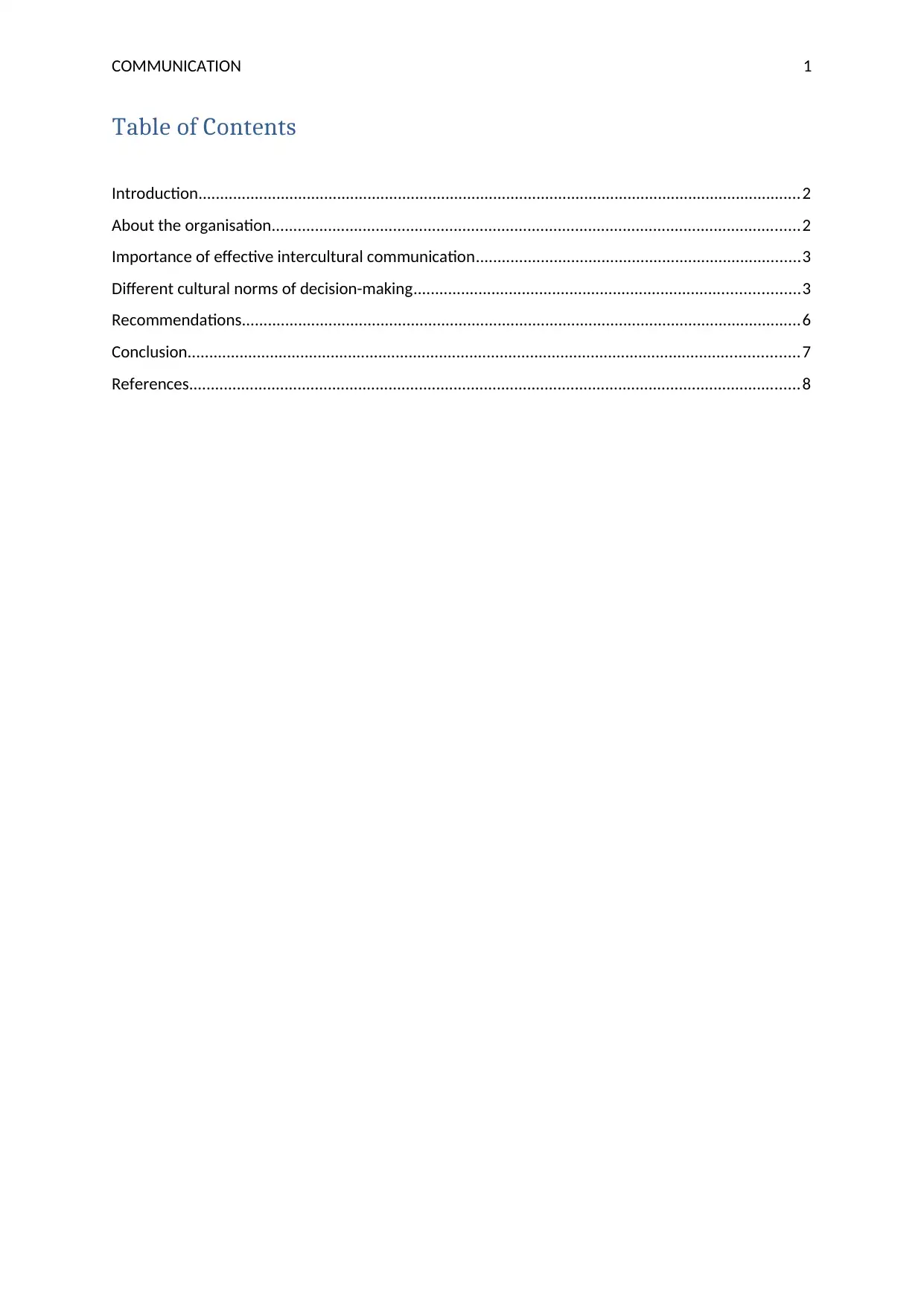
COMMUNICATION 1
Table of Contents
Introduction...........................................................................................................................................2
About the organisation..........................................................................................................................2
Importance of effective intercultural communication...........................................................................3
Different cultural norms of decision-making.........................................................................................3
Recommendations.................................................................................................................................6
Conclusion.............................................................................................................................................7
References.............................................................................................................................................8
Table of Contents
Introduction...........................................................................................................................................2
About the organisation..........................................................................................................................2
Importance of effective intercultural communication...........................................................................3
Different cultural norms of decision-making.........................................................................................3
Recommendations.................................................................................................................................6
Conclusion.............................................................................................................................................7
References.............................................................................................................................................8
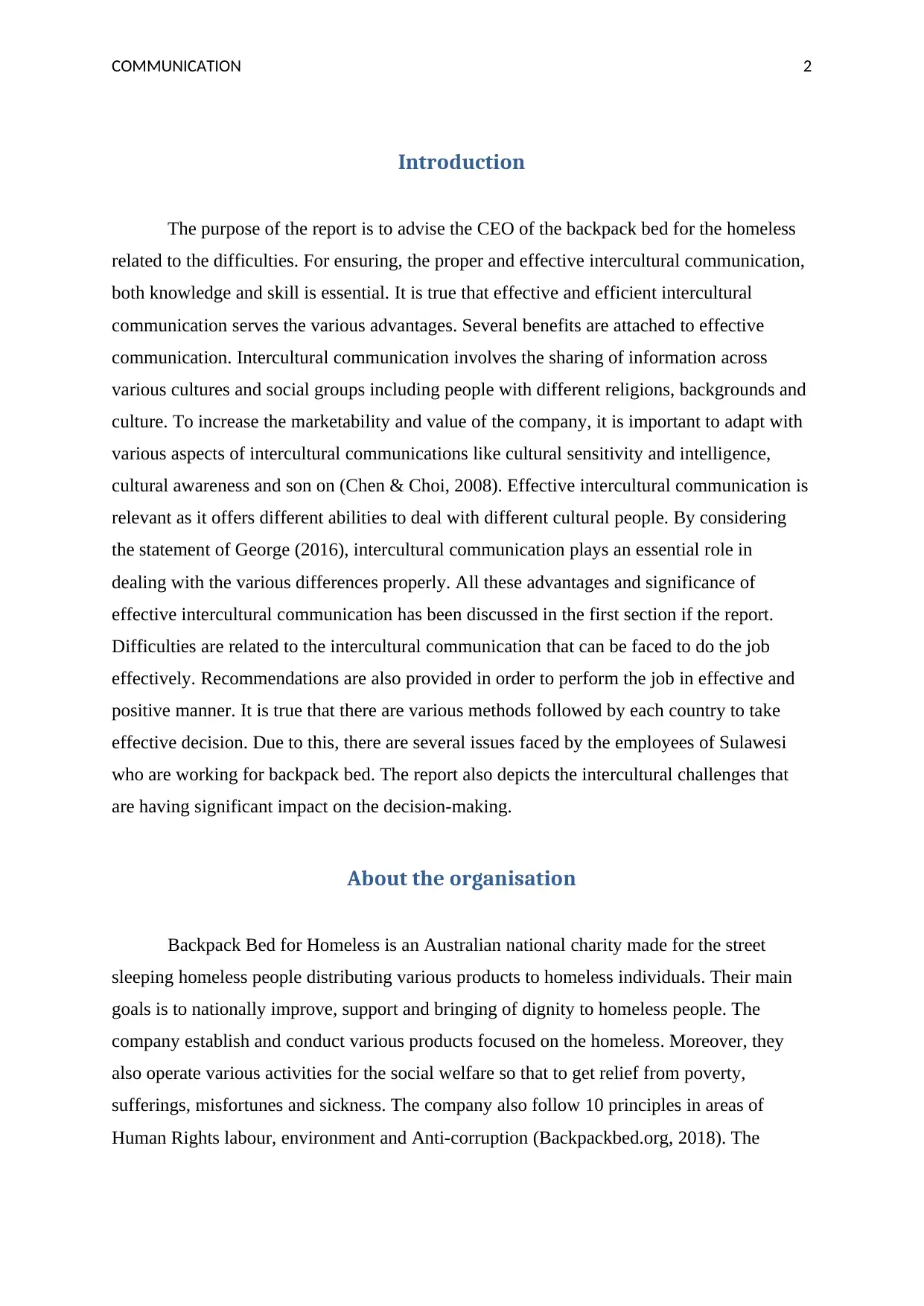
COMMUNICATION 2
Introduction
The purpose of the report is to advise the CEO of the backpack bed for the homeless
related to the difficulties. For ensuring, the proper and effective intercultural communication,
both knowledge and skill is essential. It is true that effective and efficient intercultural
communication serves the various advantages. Several benefits are attached to effective
communication. Intercultural communication involves the sharing of information across
various cultures and social groups including people with different religions, backgrounds and
culture. To increase the marketability and value of the company, it is important to adapt with
various aspects of intercultural communications like cultural sensitivity and intelligence,
cultural awareness and son on (Chen & Choi, 2008). Effective intercultural communication is
relevant as it offers different abilities to deal with different cultural people. By considering
the statement of George (2016), intercultural communication plays an essential role in
dealing with the various differences properly. All these advantages and significance of
effective intercultural communication has been discussed in the first section if the report.
Difficulties are related to the intercultural communication that can be faced to do the job
effectively. Recommendations are also provided in order to perform the job in effective and
positive manner. It is true that there are various methods followed by each country to take
effective decision. Due to this, there are several issues faced by the employees of Sulawesi
who are working for backpack bed. The report also depicts the intercultural challenges that
are having significant impact on the decision-making.
About the organisation
Backpack Bed for Homeless is an Australian national charity made for the street
sleeping homeless people distributing various products to homeless individuals. Their main
goals is to nationally improve, support and bringing of dignity to homeless people. The
company establish and conduct various products focused on the homeless. Moreover, they
also operate various activities for the social welfare so that to get relief from poverty,
sufferings, misfortunes and sickness. The company also follow 10 principles in areas of
Human Rights labour, environment and Anti-corruption (Backpackbed.org, 2018). The
Introduction
The purpose of the report is to advise the CEO of the backpack bed for the homeless
related to the difficulties. For ensuring, the proper and effective intercultural communication,
both knowledge and skill is essential. It is true that effective and efficient intercultural
communication serves the various advantages. Several benefits are attached to effective
communication. Intercultural communication involves the sharing of information across
various cultures and social groups including people with different religions, backgrounds and
culture. To increase the marketability and value of the company, it is important to adapt with
various aspects of intercultural communications like cultural sensitivity and intelligence,
cultural awareness and son on (Chen & Choi, 2008). Effective intercultural communication is
relevant as it offers different abilities to deal with different cultural people. By considering
the statement of George (2016), intercultural communication plays an essential role in
dealing with the various differences properly. All these advantages and significance of
effective intercultural communication has been discussed in the first section if the report.
Difficulties are related to the intercultural communication that can be faced to do the job
effectively. Recommendations are also provided in order to perform the job in effective and
positive manner. It is true that there are various methods followed by each country to take
effective decision. Due to this, there are several issues faced by the employees of Sulawesi
who are working for backpack bed. The report also depicts the intercultural challenges that
are having significant impact on the decision-making.
About the organisation
Backpack Bed for Homeless is an Australian national charity made for the street
sleeping homeless people distributing various products to homeless individuals. Their main
goals is to nationally improve, support and bringing of dignity to homeless people. The
company establish and conduct various products focused on the homeless. Moreover, they
also operate various activities for the social welfare so that to get relief from poverty,
sufferings, misfortunes and sickness. The company also follow 10 principles in areas of
Human Rights labour, environment and Anti-corruption (Backpackbed.org, 2018). The
⊘ This is a preview!⊘
Do you want full access?
Subscribe today to unlock all pages.

Trusted by 1+ million students worldwide
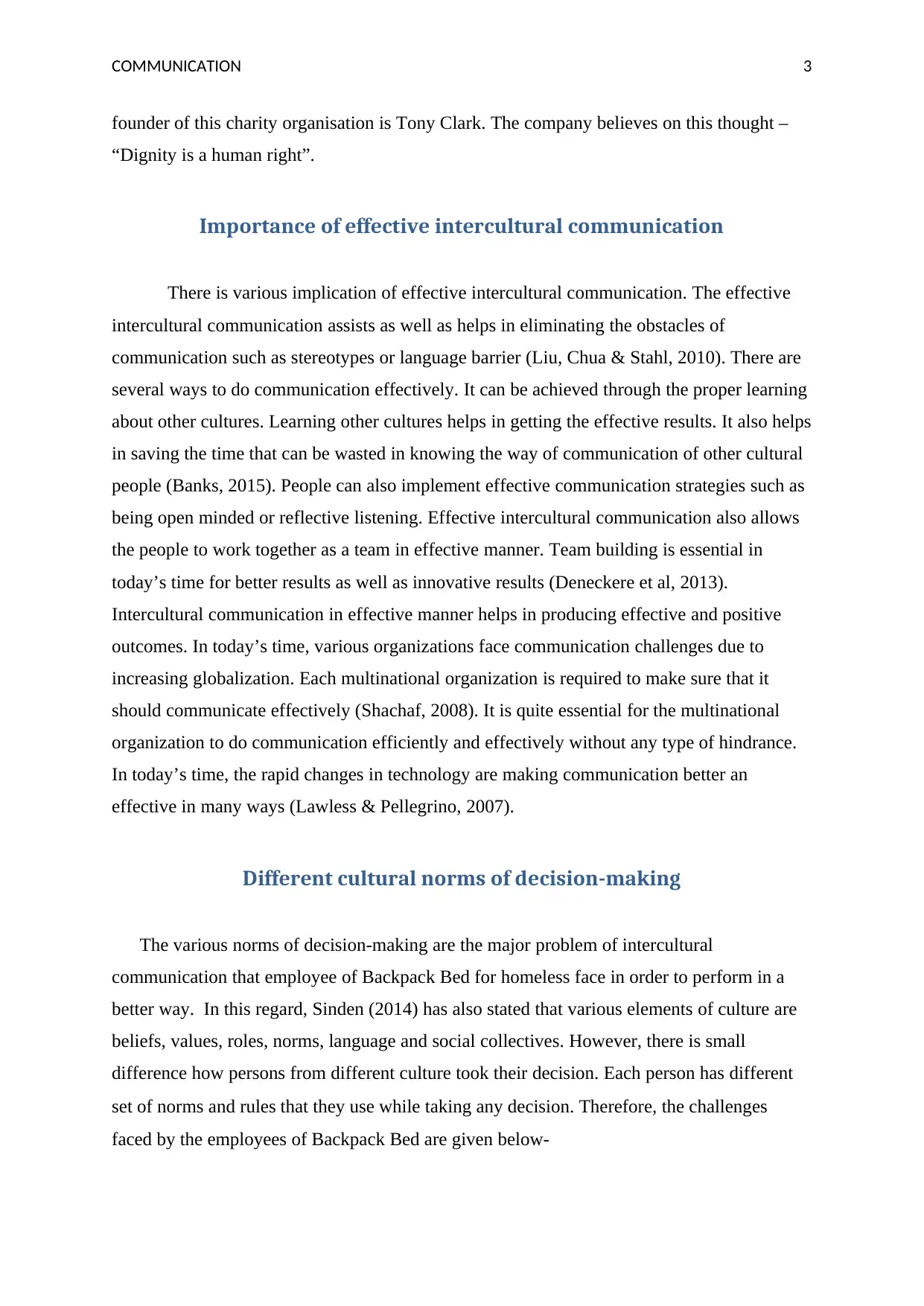
COMMUNICATION 3
founder of this charity organisation is Tony Clark. The company believes on this thought –
“Dignity is a human right”.
Importance of effective intercultural communication
There is various implication of effective intercultural communication. The effective
intercultural communication assists as well as helps in eliminating the obstacles of
communication such as stereotypes or language barrier (Liu, Chua & Stahl, 2010). There are
several ways to do communication effectively. It can be achieved through the proper learning
about other cultures. Learning other cultures helps in getting the effective results. It also helps
in saving the time that can be wasted in knowing the way of communication of other cultural
people (Banks, 2015). People can also implement effective communication strategies such as
being open minded or reflective listening. Effective intercultural communication also allows
the people to work together as a team in effective manner. Team building is essential in
today’s time for better results as well as innovative results (Deneckere et al, 2013).
Intercultural communication in effective manner helps in producing effective and positive
outcomes. In today’s time, various organizations face communication challenges due to
increasing globalization. Each multinational organization is required to make sure that it
should communicate effectively (Shachaf, 2008). It is quite essential for the multinational
organization to do communication efficiently and effectively without any type of hindrance.
In today’s time, the rapid changes in technology are making communication better an
effective in many ways (Lawless & Pellegrino, 2007).
Different cultural norms of decision-making
The various norms of decision-making are the major problem of intercultural
communication that employee of Backpack Bed for homeless face in order to perform in a
better way. In this regard, Sinden (2014) has also stated that various elements of culture are
beliefs, values, roles, norms, language and social collectives. However, there is small
difference how persons from different culture took their decision. Each person has different
set of norms and rules that they use while taking any decision. Therefore, the challenges
faced by the employees of Backpack Bed are given below-
founder of this charity organisation is Tony Clark. The company believes on this thought –
“Dignity is a human right”.
Importance of effective intercultural communication
There is various implication of effective intercultural communication. The effective
intercultural communication assists as well as helps in eliminating the obstacles of
communication such as stereotypes or language barrier (Liu, Chua & Stahl, 2010). There are
several ways to do communication effectively. It can be achieved through the proper learning
about other cultures. Learning other cultures helps in getting the effective results. It also helps
in saving the time that can be wasted in knowing the way of communication of other cultural
people (Banks, 2015). People can also implement effective communication strategies such as
being open minded or reflective listening. Effective intercultural communication also allows
the people to work together as a team in effective manner. Team building is essential in
today’s time for better results as well as innovative results (Deneckere et al, 2013).
Intercultural communication in effective manner helps in producing effective and positive
outcomes. In today’s time, various organizations face communication challenges due to
increasing globalization. Each multinational organization is required to make sure that it
should communicate effectively (Shachaf, 2008). It is quite essential for the multinational
organization to do communication efficiently and effectively without any type of hindrance.
In today’s time, the rapid changes in technology are making communication better an
effective in many ways (Lawless & Pellegrino, 2007).
Different cultural norms of decision-making
The various norms of decision-making are the major problem of intercultural
communication that employee of Backpack Bed for homeless face in order to perform in a
better way. In this regard, Sinden (2014) has also stated that various elements of culture are
beliefs, values, roles, norms, language and social collectives. However, there is small
difference how persons from different culture took their decision. Each person has different
set of norms and rules that they use while taking any decision. Therefore, the challenges
faced by the employees of Backpack Bed are given below-
Paraphrase This Document
Need a fresh take? Get an instant paraphrase of this document with our AI Paraphraser
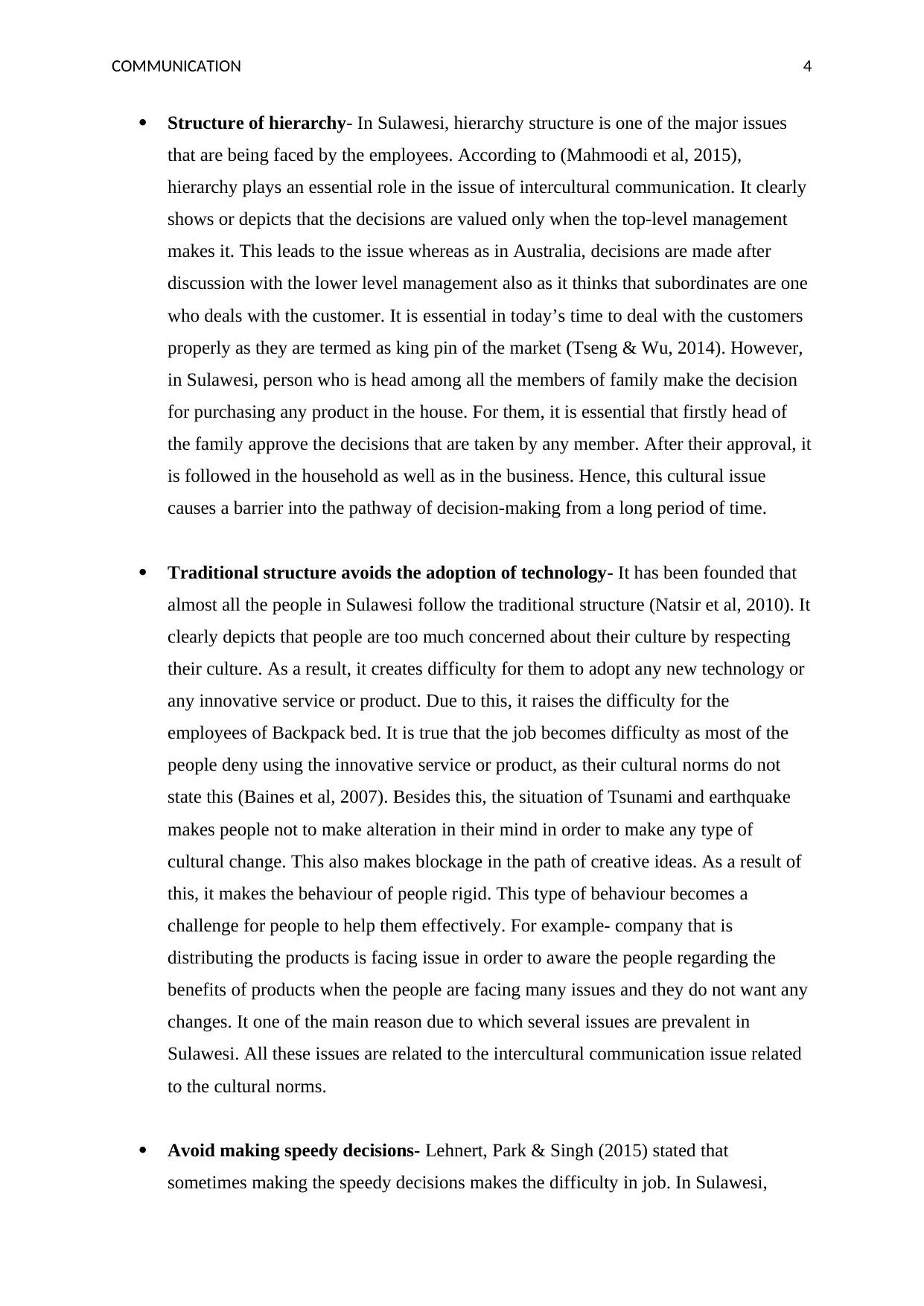
COMMUNICATION 4
Structure of hierarchy- In Sulawesi, hierarchy structure is one of the major issues
that are being faced by the employees. According to (Mahmoodi et al, 2015),
hierarchy plays an essential role in the issue of intercultural communication. It clearly
shows or depicts that the decisions are valued only when the top-level management
makes it. This leads to the issue whereas as in Australia, decisions are made after
discussion with the lower level management also as it thinks that subordinates are one
who deals with the customer. It is essential in today’s time to deal with the customers
properly as they are termed as king pin of the market (Tseng & Wu, 2014). However,
in Sulawesi, person who is head among all the members of family make the decision
for purchasing any product in the house. For them, it is essential that firstly head of
the family approve the decisions that are taken by any member. After their approval, it
is followed in the household as well as in the business. Hence, this cultural issue
causes a barrier into the pathway of decision-making from a long period of time.
Traditional structure avoids the adoption of technology- It has been founded that
almost all the people in Sulawesi follow the traditional structure (Natsir et al, 2010). It
clearly depicts that people are too much concerned about their culture by respecting
their culture. As a result, it creates difficulty for them to adopt any new technology or
any innovative service or product. Due to this, it raises the difficulty for the
employees of Backpack bed. It is true that the job becomes difficulty as most of the
people deny using the innovative service or product, as their cultural norms do not
state this (Baines et al, 2007). Besides this, the situation of Tsunami and earthquake
makes people not to make alteration in their mind in order to make any type of
cultural change. This also makes blockage in the path of creative ideas. As a result of
this, it makes the behaviour of people rigid. This type of behaviour becomes a
challenge for people to help them effectively. For example- company that is
distributing the products is facing issue in order to aware the people regarding the
benefits of products when the people are facing many issues and they do not want any
changes. It one of the main reason due to which several issues are prevalent in
Sulawesi. All these issues are related to the intercultural communication issue related
to the cultural norms.
Avoid making speedy decisions- Lehnert, Park & Singh (2015) stated that
sometimes making the speedy decisions makes the difficulty in job. In Sulawesi,
Structure of hierarchy- In Sulawesi, hierarchy structure is one of the major issues
that are being faced by the employees. According to (Mahmoodi et al, 2015),
hierarchy plays an essential role in the issue of intercultural communication. It clearly
shows or depicts that the decisions are valued only when the top-level management
makes it. This leads to the issue whereas as in Australia, decisions are made after
discussion with the lower level management also as it thinks that subordinates are one
who deals with the customer. It is essential in today’s time to deal with the customers
properly as they are termed as king pin of the market (Tseng & Wu, 2014). However,
in Sulawesi, person who is head among all the members of family make the decision
for purchasing any product in the house. For them, it is essential that firstly head of
the family approve the decisions that are taken by any member. After their approval, it
is followed in the household as well as in the business. Hence, this cultural issue
causes a barrier into the pathway of decision-making from a long period of time.
Traditional structure avoids the adoption of technology- It has been founded that
almost all the people in Sulawesi follow the traditional structure (Natsir et al, 2010). It
clearly depicts that people are too much concerned about their culture by respecting
their culture. As a result, it creates difficulty for them to adopt any new technology or
any innovative service or product. Due to this, it raises the difficulty for the
employees of Backpack bed. It is true that the job becomes difficulty as most of the
people deny using the innovative service or product, as their cultural norms do not
state this (Baines et al, 2007). Besides this, the situation of Tsunami and earthquake
makes people not to make alteration in their mind in order to make any type of
cultural change. This also makes blockage in the path of creative ideas. As a result of
this, it makes the behaviour of people rigid. This type of behaviour becomes a
challenge for people to help them effectively. For example- company that is
distributing the products is facing issue in order to aware the people regarding the
benefits of products when the people are facing many issues and they do not want any
changes. It one of the main reason due to which several issues are prevalent in
Sulawesi. All these issues are related to the intercultural communication issue related
to the cultural norms.
Avoid making speedy decisions- Lehnert, Park & Singh (2015) stated that
sometimes making the speedy decisions makes the difficulty in job. In Sulawesi,
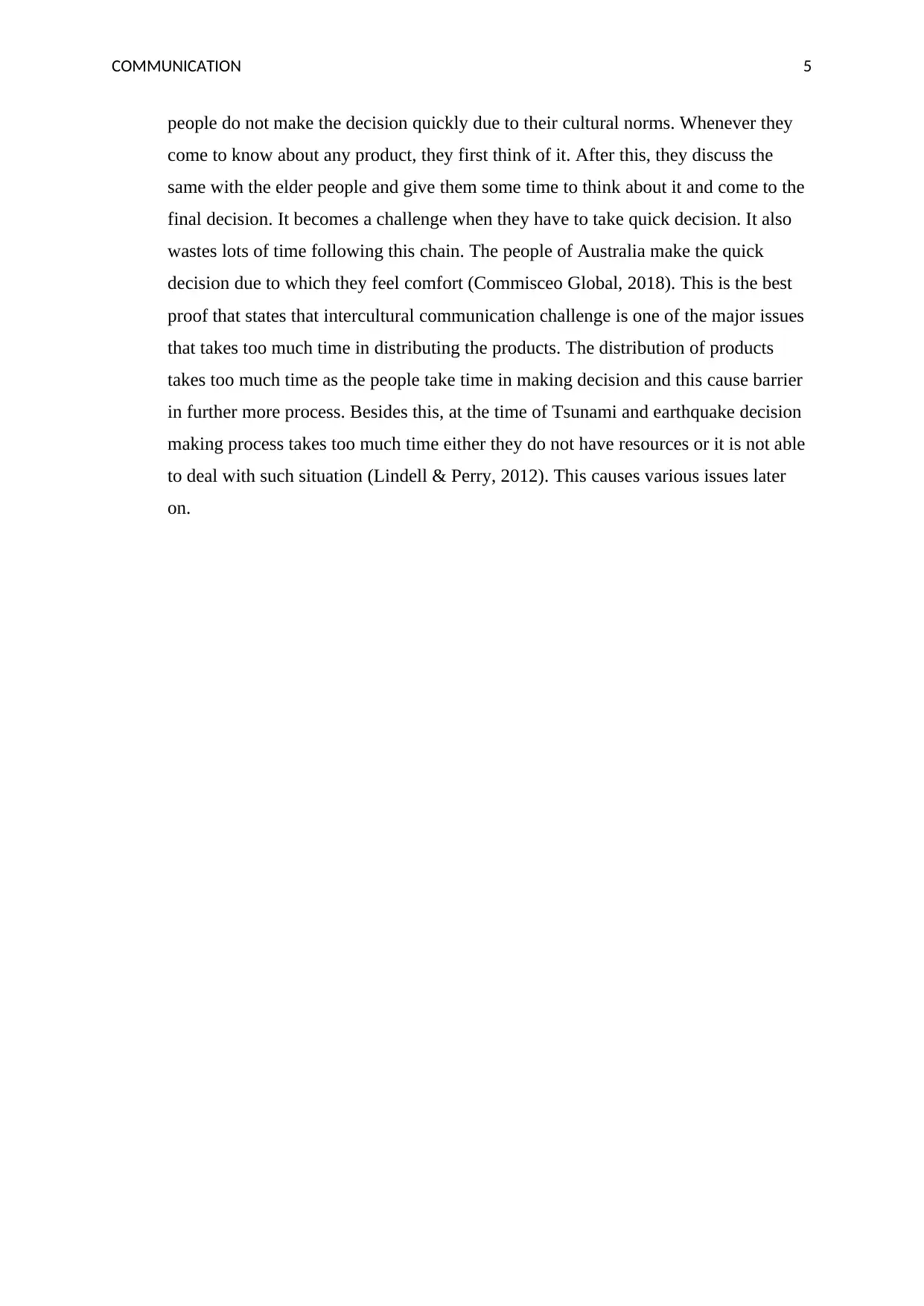
COMMUNICATION 5
people do not make the decision quickly due to their cultural norms. Whenever they
come to know about any product, they first think of it. After this, they discuss the
same with the elder people and give them some time to think about it and come to the
final decision. It becomes a challenge when they have to take quick decision. It also
wastes lots of time following this chain. The people of Australia make the quick
decision due to which they feel comfort (Commisceo Global, 2018). This is the best
proof that states that intercultural communication challenge is one of the major issues
that takes too much time in distributing the products. The distribution of products
takes too much time as the people take time in making decision and this cause barrier
in further more process. Besides this, at the time of Tsunami and earthquake decision
making process takes too much time either they do not have resources or it is not able
to deal with such situation (Lindell & Perry, 2012). This causes various issues later
on.
people do not make the decision quickly due to their cultural norms. Whenever they
come to know about any product, they first think of it. After this, they discuss the
same with the elder people and give them some time to think about it and come to the
final decision. It becomes a challenge when they have to take quick decision. It also
wastes lots of time following this chain. The people of Australia make the quick
decision due to which they feel comfort (Commisceo Global, 2018). This is the best
proof that states that intercultural communication challenge is one of the major issues
that takes too much time in distributing the products. The distribution of products
takes too much time as the people take time in making decision and this cause barrier
in further more process. Besides this, at the time of Tsunami and earthquake decision
making process takes too much time either they do not have resources or it is not able
to deal with such situation (Lindell & Perry, 2012). This causes various issues later
on.
⊘ This is a preview!⊘
Do you want full access?
Subscribe today to unlock all pages.

Trusted by 1+ million students worldwide
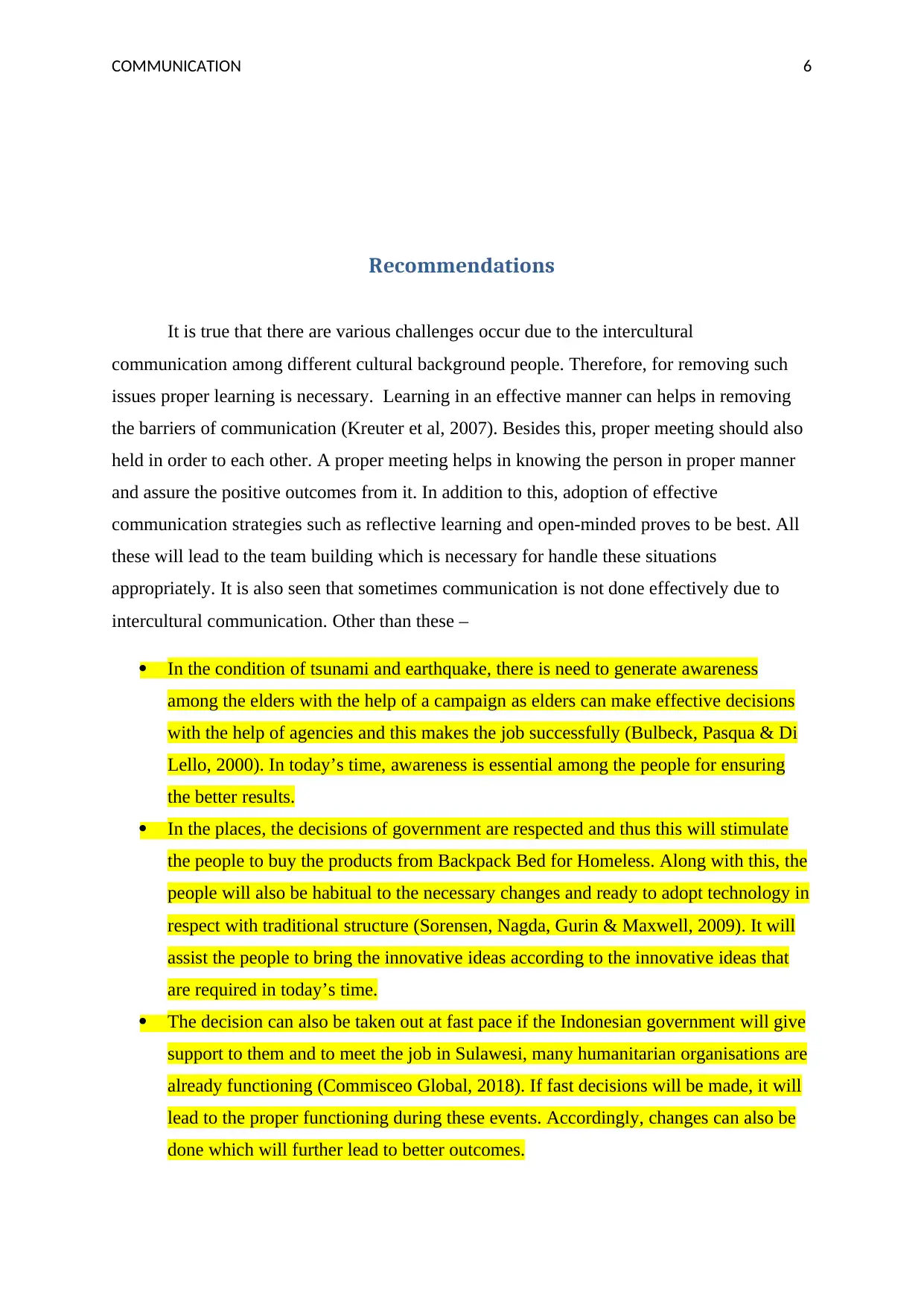
COMMUNICATION 6
Recommendations
It is true that there are various challenges occur due to the intercultural
communication among different cultural background people. Therefore, for removing such
issues proper learning is necessary. Learning in an effective manner can helps in removing
the barriers of communication (Kreuter et al, 2007). Besides this, proper meeting should also
held in order to each other. A proper meeting helps in knowing the person in proper manner
and assure the positive outcomes from it. In addition to this, adoption of effective
communication strategies such as reflective learning and open-minded proves to be best. All
these will lead to the team building which is necessary for handle these situations
appropriately. It is also seen that sometimes communication is not done effectively due to
intercultural communication. Other than these –
In the condition of tsunami and earthquake, there is need to generate awareness
among the elders with the help of a campaign as elders can make effective decisions
with the help of agencies and this makes the job successfully (Bulbeck, Pasqua & Di
Lello, 2000). In today’s time, awareness is essential among the people for ensuring
the better results.
In the places, the decisions of government are respected and thus this will stimulate
the people to buy the products from Backpack Bed for Homeless. Along with this, the
people will also be habitual to the necessary changes and ready to adopt technology in
respect with traditional structure (Sorensen, Nagda, Gurin & Maxwell, 2009). It will
assist the people to bring the innovative ideas according to the innovative ideas that
are required in today’s time.
The decision can also be taken out at fast pace if the Indonesian government will give
support to them and to meet the job in Sulawesi, many humanitarian organisations are
already functioning (Commisceo Global, 2018). If fast decisions will be made, it will
lead to the proper functioning during these events. Accordingly, changes can also be
done which will further lead to better outcomes.
Recommendations
It is true that there are various challenges occur due to the intercultural
communication among different cultural background people. Therefore, for removing such
issues proper learning is necessary. Learning in an effective manner can helps in removing
the barriers of communication (Kreuter et al, 2007). Besides this, proper meeting should also
held in order to each other. A proper meeting helps in knowing the person in proper manner
and assure the positive outcomes from it. In addition to this, adoption of effective
communication strategies such as reflective learning and open-minded proves to be best. All
these will lead to the team building which is necessary for handle these situations
appropriately. It is also seen that sometimes communication is not done effectively due to
intercultural communication. Other than these –
In the condition of tsunami and earthquake, there is need to generate awareness
among the elders with the help of a campaign as elders can make effective decisions
with the help of agencies and this makes the job successfully (Bulbeck, Pasqua & Di
Lello, 2000). In today’s time, awareness is essential among the people for ensuring
the better results.
In the places, the decisions of government are respected and thus this will stimulate
the people to buy the products from Backpack Bed for Homeless. Along with this, the
people will also be habitual to the necessary changes and ready to adopt technology in
respect with traditional structure (Sorensen, Nagda, Gurin & Maxwell, 2009). It will
assist the people to bring the innovative ideas according to the innovative ideas that
are required in today’s time.
The decision can also be taken out at fast pace if the Indonesian government will give
support to them and to meet the job in Sulawesi, many humanitarian organisations are
already functioning (Commisceo Global, 2018). If fast decisions will be made, it will
lead to the proper functioning during these events. Accordingly, changes can also be
done which will further lead to better outcomes.
Paraphrase This Document
Need a fresh take? Get an instant paraphrase of this document with our AI Paraphraser

COMMUNICATION 7
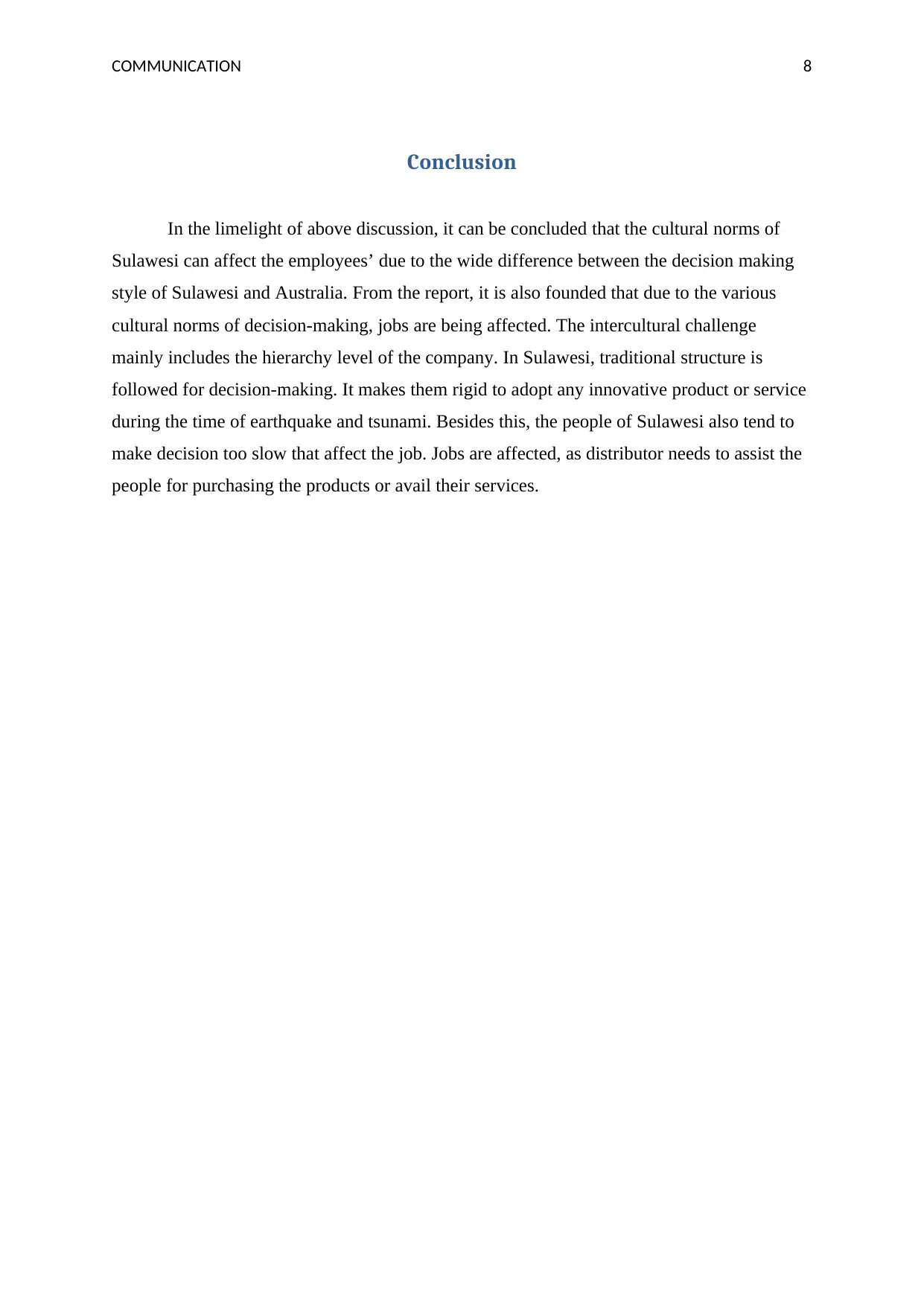
COMMUNICATION 8
Conclusion
In the limelight of above discussion, it can be concluded that the cultural norms of
Sulawesi can affect the employees’ due to the wide difference between the decision making
style of Sulawesi and Australia. From the report, it is also founded that due to the various
cultural norms of decision-making, jobs are being affected. The intercultural challenge
mainly includes the hierarchy level of the company. In Sulawesi, traditional structure is
followed for decision-making. It makes them rigid to adopt any innovative product or service
during the time of earthquake and tsunami. Besides this, the people of Sulawesi also tend to
make decision too slow that affect the job. Jobs are affected, as distributor needs to assist the
people for purchasing the products or avail their services.
Conclusion
In the limelight of above discussion, it can be concluded that the cultural norms of
Sulawesi can affect the employees’ due to the wide difference between the decision making
style of Sulawesi and Australia. From the report, it is also founded that due to the various
cultural norms of decision-making, jobs are being affected. The intercultural challenge
mainly includes the hierarchy level of the company. In Sulawesi, traditional structure is
followed for decision-making. It makes them rigid to adopt any innovative product or service
during the time of earthquake and tsunami. Besides this, the people of Sulawesi also tend to
make decision too slow that affect the job. Jobs are affected, as distributor needs to assist the
people for purchasing the products or avail their services.
⊘ This is a preview!⊘
Do you want full access?
Subscribe today to unlock all pages.

Trusted by 1+ million students worldwide
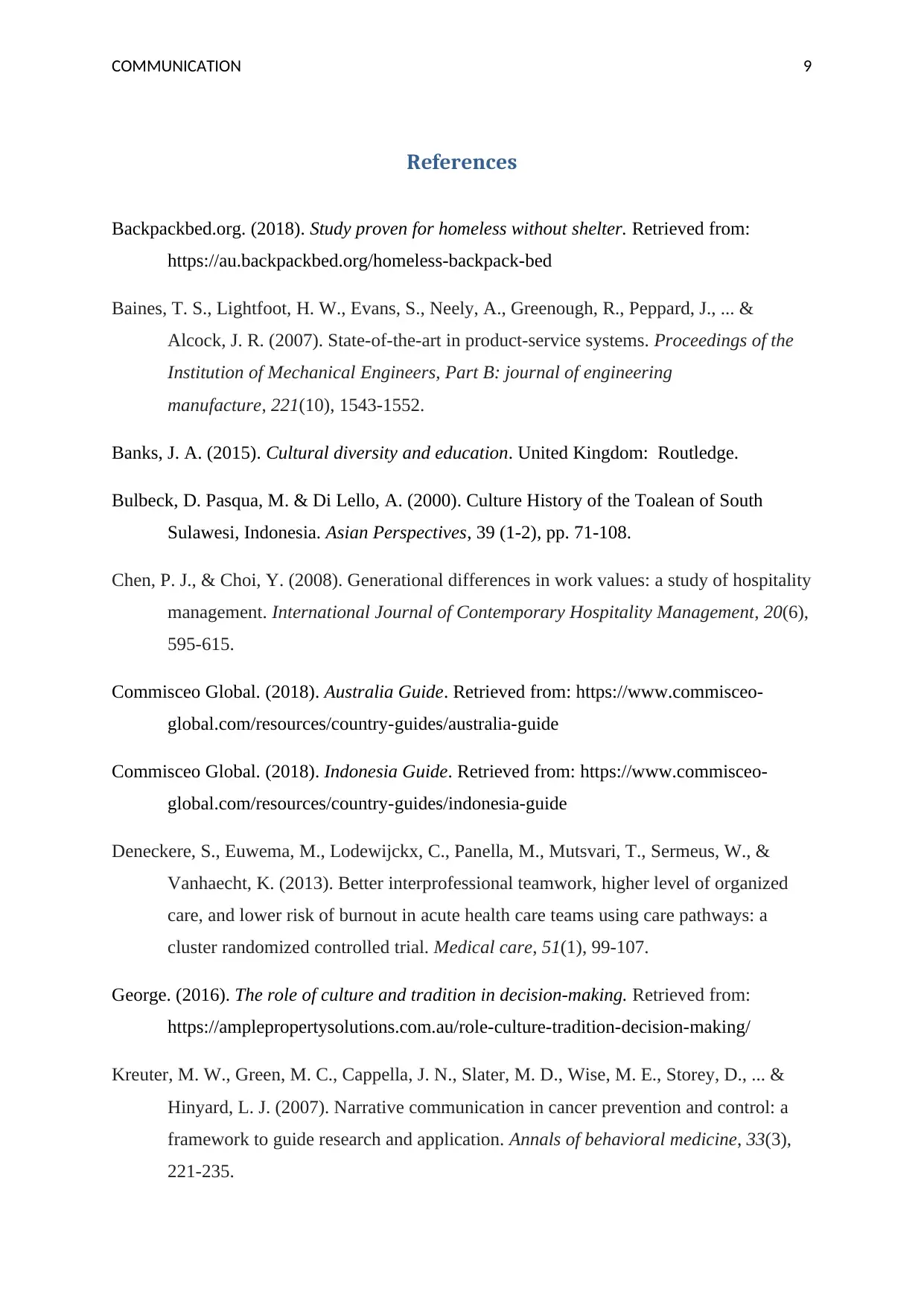
COMMUNICATION 9
References
Backpackbed.org. (2018). Study proven for homeless without shelter. Retrieved from:
https://au.backpackbed.org/homeless-backpack-bed
Baines, T. S., Lightfoot, H. W., Evans, S., Neely, A., Greenough, R., Peppard, J., ... &
Alcock, J. R. (2007). State-of-the-art in product-service systems. Proceedings of the
Institution of Mechanical Engineers, Part B: journal of engineering
manufacture, 221(10), 1543-1552.
Banks, J. A. (2015). Cultural diversity and education. United Kingdom: Routledge.
Bulbeck, D. Pasqua, M. & Di Lello, A. (2000). Culture History of the Toalean of South
Sulawesi, Indonesia. Asian Perspectives, 39 (1-2), pp. 71-108.
Chen, P. J., & Choi, Y. (2008). Generational differences in work values: a study of hospitality
management. International Journal of Contemporary Hospitality Management, 20(6),
595-615.
Commisceo Global. (2018). Australia Guide. Retrieved from: https://www.commisceo-
global.com/resources/country-guides/australia-guide
Commisceo Global. (2018). Indonesia Guide. Retrieved from: https://www.commisceo-
global.com/resources/country-guides/indonesia-guide
Deneckere, S., Euwema, M., Lodewijckx, C., Panella, M., Mutsvari, T., Sermeus, W., &
Vanhaecht, K. (2013). Better interprofessional teamwork, higher level of organized
care, and lower risk of burnout in acute health care teams using care pathways: a
cluster randomized controlled trial. Medical care, 51(1), 99-107.
George. (2016). The role of culture and tradition in decision-making. Retrieved from:
https://amplepropertysolutions.com.au/role-culture-tradition-decision-making/
Kreuter, M. W., Green, M. C., Cappella, J. N., Slater, M. D., Wise, M. E., Storey, D., ... &
Hinyard, L. J. (2007). Narrative communication in cancer prevention and control: a
framework to guide research and application. Annals of behavioral medicine, 33(3),
221-235.
References
Backpackbed.org. (2018). Study proven for homeless without shelter. Retrieved from:
https://au.backpackbed.org/homeless-backpack-bed
Baines, T. S., Lightfoot, H. W., Evans, S., Neely, A., Greenough, R., Peppard, J., ... &
Alcock, J. R. (2007). State-of-the-art in product-service systems. Proceedings of the
Institution of Mechanical Engineers, Part B: journal of engineering
manufacture, 221(10), 1543-1552.
Banks, J. A. (2015). Cultural diversity and education. United Kingdom: Routledge.
Bulbeck, D. Pasqua, M. & Di Lello, A. (2000). Culture History of the Toalean of South
Sulawesi, Indonesia. Asian Perspectives, 39 (1-2), pp. 71-108.
Chen, P. J., & Choi, Y. (2008). Generational differences in work values: a study of hospitality
management. International Journal of Contemporary Hospitality Management, 20(6),
595-615.
Commisceo Global. (2018). Australia Guide. Retrieved from: https://www.commisceo-
global.com/resources/country-guides/australia-guide
Commisceo Global. (2018). Indonesia Guide. Retrieved from: https://www.commisceo-
global.com/resources/country-guides/indonesia-guide
Deneckere, S., Euwema, M., Lodewijckx, C., Panella, M., Mutsvari, T., Sermeus, W., &
Vanhaecht, K. (2013). Better interprofessional teamwork, higher level of organized
care, and lower risk of burnout in acute health care teams using care pathways: a
cluster randomized controlled trial. Medical care, 51(1), 99-107.
George. (2016). The role of culture and tradition in decision-making. Retrieved from:
https://amplepropertysolutions.com.au/role-culture-tradition-decision-making/
Kreuter, M. W., Green, M. C., Cappella, J. N., Slater, M. D., Wise, M. E., Storey, D., ... &
Hinyard, L. J. (2007). Narrative communication in cancer prevention and control: a
framework to guide research and application. Annals of behavioral medicine, 33(3),
221-235.
Paraphrase This Document
Need a fresh take? Get an instant paraphrase of this document with our AI Paraphraser
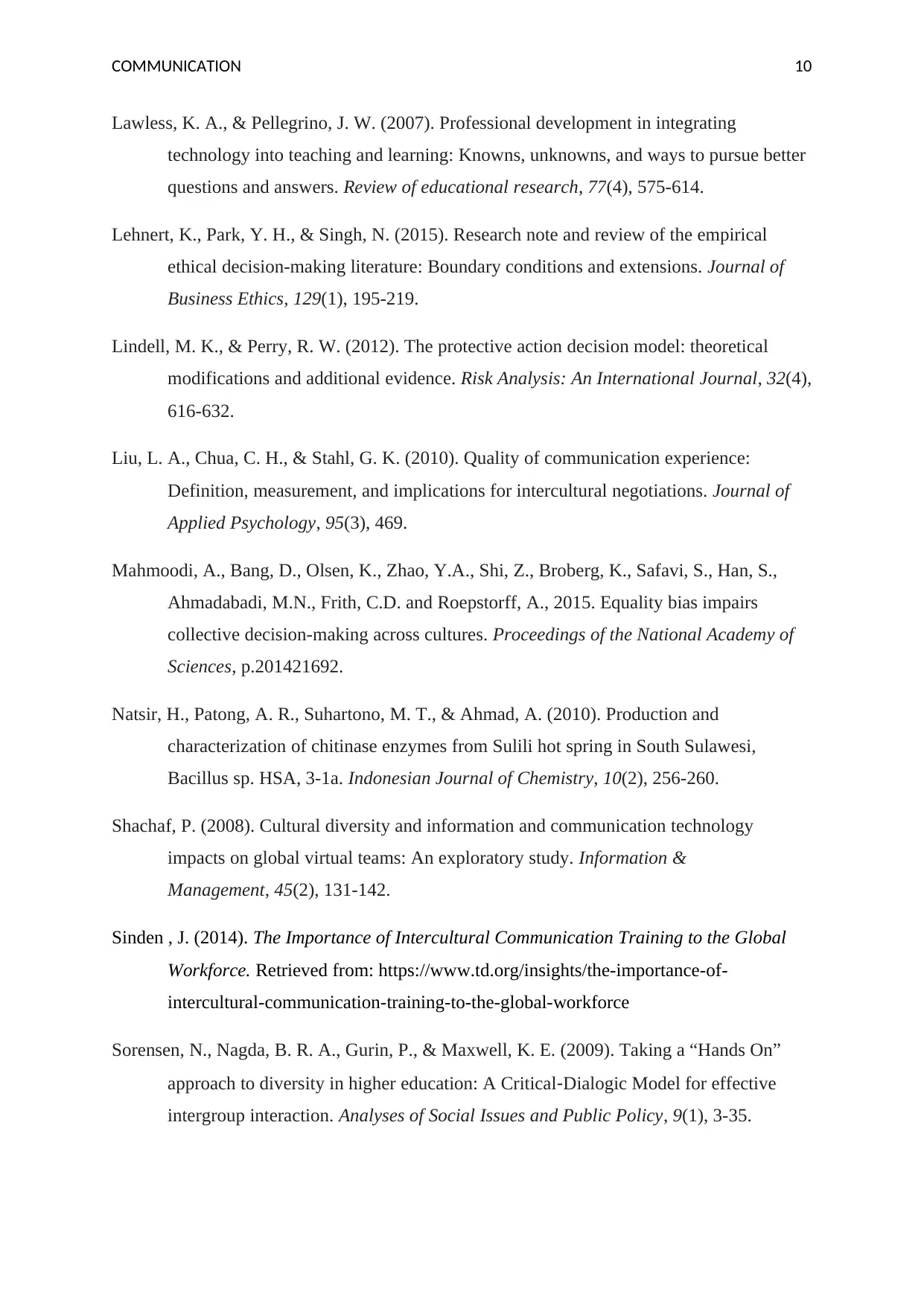
COMMUNICATION 10
Lawless, K. A., & Pellegrino, J. W. (2007). Professional development in integrating
technology into teaching and learning: Knowns, unknowns, and ways to pursue better
questions and answers. Review of educational research, 77(4), 575-614.
Lehnert, K., Park, Y. H., & Singh, N. (2015). Research note and review of the empirical
ethical decision-making literature: Boundary conditions and extensions. Journal of
Business Ethics, 129(1), 195-219.
Lindell, M. K., & Perry, R. W. (2012). The protective action decision model: theoretical
modifications and additional evidence. Risk Analysis: An International Journal, 32(4),
616-632.
Liu, L. A., Chua, C. H., & Stahl, G. K. (2010). Quality of communication experience:
Definition, measurement, and implications for intercultural negotiations. Journal of
Applied Psychology, 95(3), 469.
Mahmoodi, A., Bang, D., Olsen, K., Zhao, Y.A., Shi, Z., Broberg, K., Safavi, S., Han, S.,
Ahmadabadi, M.N., Frith, C.D. and Roepstorff, A., 2015. Equality bias impairs
collective decision-making across cultures. Proceedings of the National Academy of
Sciences, p.201421692.
Natsir, H., Patong, A. R., Suhartono, M. T., & Ahmad, A. (2010). Production and
characterization of chitinase enzymes from Sulili hot spring in South Sulawesi,
Bacillus sp. HSA, 3-1a. Indonesian Journal of Chemistry, 10(2), 256-260.
Shachaf, P. (2008). Cultural diversity and information and communication technology
impacts on global virtual teams: An exploratory study. Information &
Management, 45(2), 131-142.
Sinden , J. (2014). The Importance of Intercultural Communication Training to the Global
Workforce. Retrieved from: https://www.td.org/insights/the-importance-of-
intercultural-communication-training-to-the-global-workforce
Sorensen, N., Nagda, B. R. A., Gurin, P., & Maxwell, K. E. (2009). Taking a “Hands On”
approach to diversity in higher education: A Critical‐Dialogic Model for effective
intergroup interaction. Analyses of Social Issues and Public Policy, 9(1), 3-35.
Lawless, K. A., & Pellegrino, J. W. (2007). Professional development in integrating
technology into teaching and learning: Knowns, unknowns, and ways to pursue better
questions and answers. Review of educational research, 77(4), 575-614.
Lehnert, K., Park, Y. H., & Singh, N. (2015). Research note and review of the empirical
ethical decision-making literature: Boundary conditions and extensions. Journal of
Business Ethics, 129(1), 195-219.
Lindell, M. K., & Perry, R. W. (2012). The protective action decision model: theoretical
modifications and additional evidence. Risk Analysis: An International Journal, 32(4),
616-632.
Liu, L. A., Chua, C. H., & Stahl, G. K. (2010). Quality of communication experience:
Definition, measurement, and implications for intercultural negotiations. Journal of
Applied Psychology, 95(3), 469.
Mahmoodi, A., Bang, D., Olsen, K., Zhao, Y.A., Shi, Z., Broberg, K., Safavi, S., Han, S.,
Ahmadabadi, M.N., Frith, C.D. and Roepstorff, A., 2015. Equality bias impairs
collective decision-making across cultures. Proceedings of the National Academy of
Sciences, p.201421692.
Natsir, H., Patong, A. R., Suhartono, M. T., & Ahmad, A. (2010). Production and
characterization of chitinase enzymes from Sulili hot spring in South Sulawesi,
Bacillus sp. HSA, 3-1a. Indonesian Journal of Chemistry, 10(2), 256-260.
Shachaf, P. (2008). Cultural diversity and information and communication technology
impacts on global virtual teams: An exploratory study. Information &
Management, 45(2), 131-142.
Sinden , J. (2014). The Importance of Intercultural Communication Training to the Global
Workforce. Retrieved from: https://www.td.org/insights/the-importance-of-
intercultural-communication-training-to-the-global-workforce
Sorensen, N., Nagda, B. R. A., Gurin, P., & Maxwell, K. E. (2009). Taking a “Hands On”
approach to diversity in higher education: A Critical‐Dialogic Model for effective
intergroup interaction. Analyses of Social Issues and Public Policy, 9(1), 3-35.
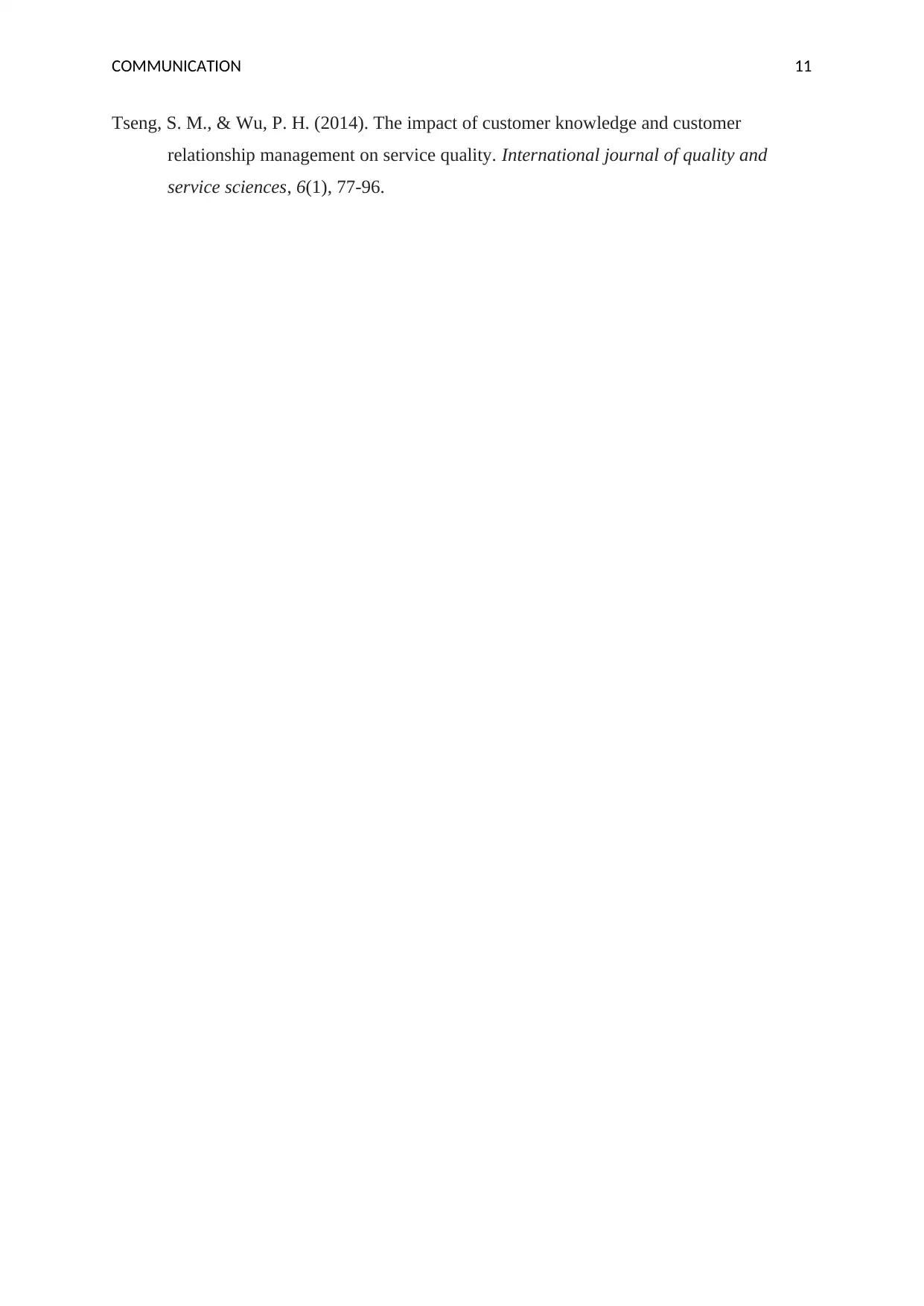
COMMUNICATION 11
Tseng, S. M., & Wu, P. H. (2014). The impact of customer knowledge and customer
relationship management on service quality. International journal of quality and
service sciences, 6(1), 77-96.
Tseng, S. M., & Wu, P. H. (2014). The impact of customer knowledge and customer
relationship management on service quality. International journal of quality and
service sciences, 6(1), 77-96.
⊘ This is a preview!⊘
Do you want full access?
Subscribe today to unlock all pages.

Trusted by 1+ million students worldwide
1 out of 12
Related Documents
Your All-in-One AI-Powered Toolkit for Academic Success.
+13062052269
info@desklib.com
Available 24*7 on WhatsApp / Email
![[object Object]](/_next/static/media/star-bottom.7253800d.svg)
Unlock your academic potential
Copyright © 2020–2025 A2Z Services. All Rights Reserved. Developed and managed by ZUCOL.



